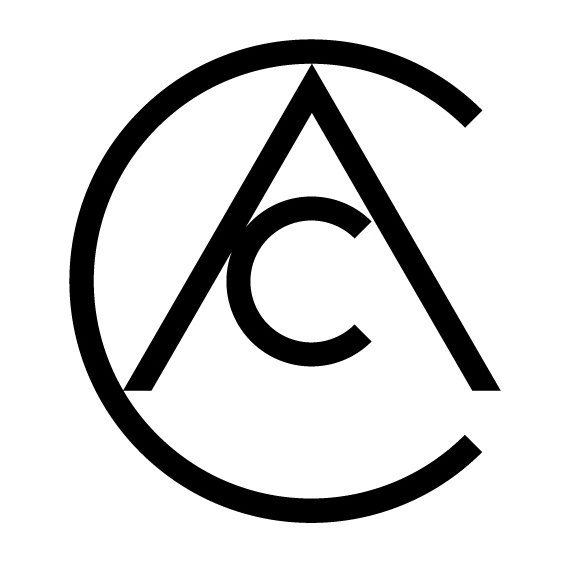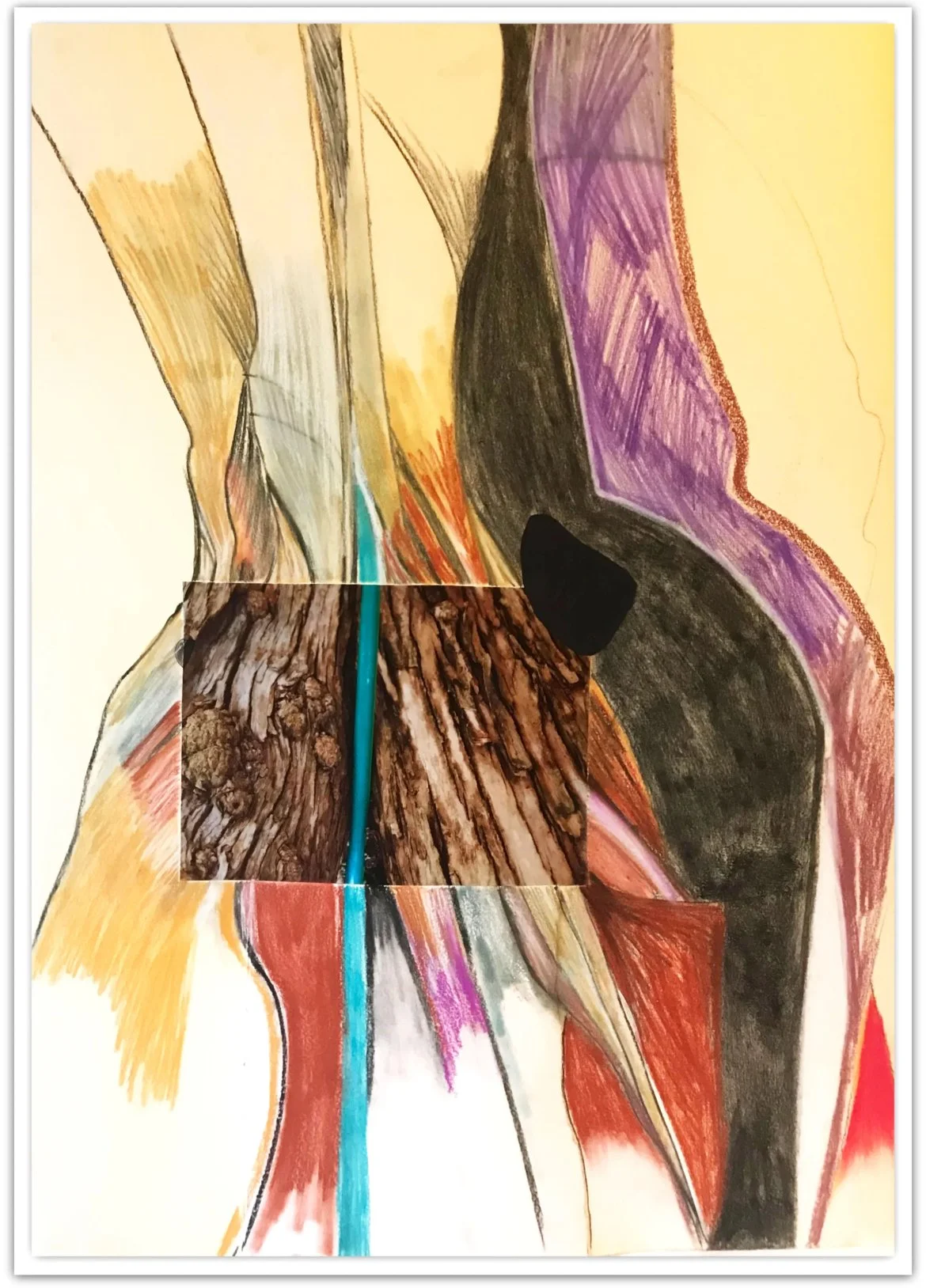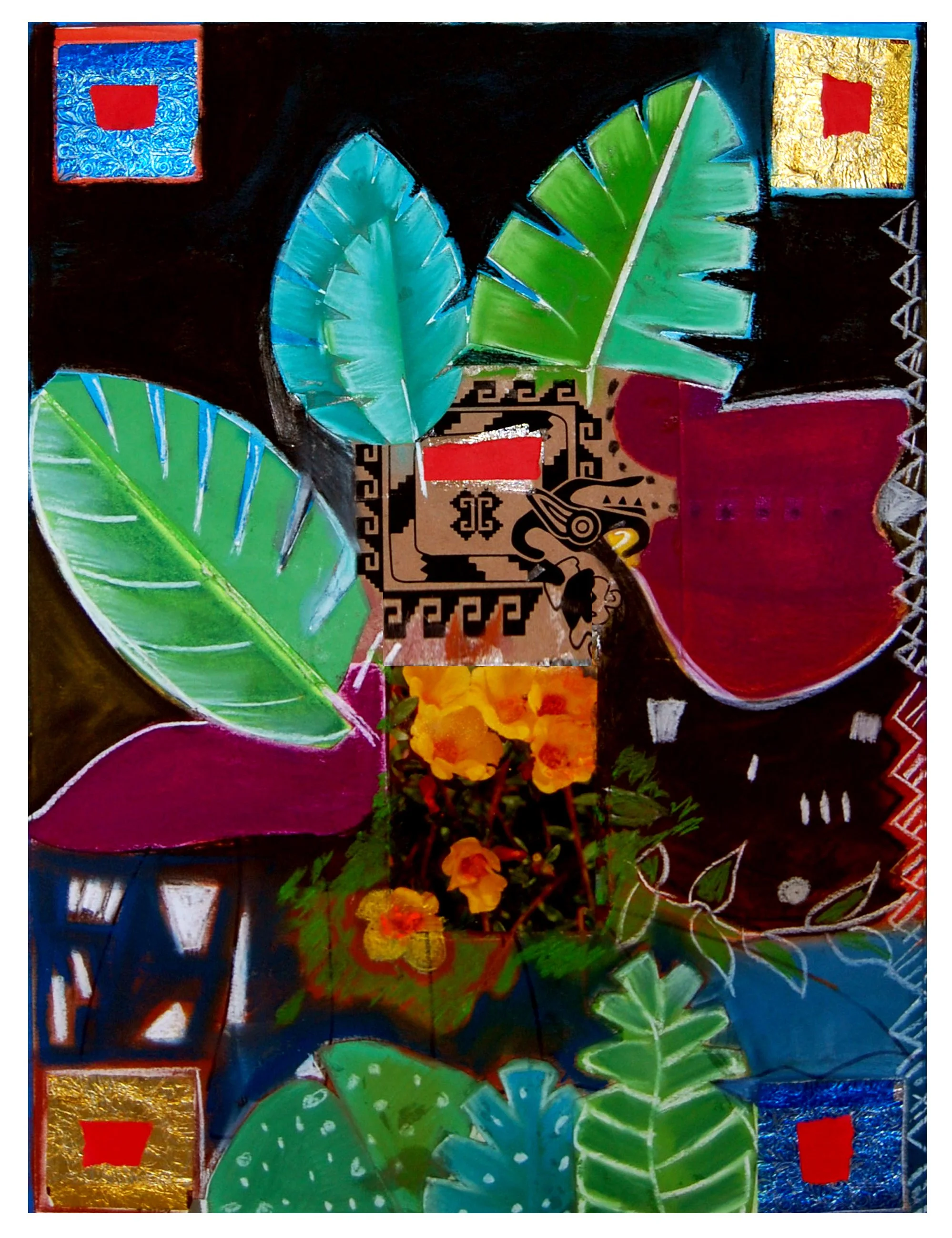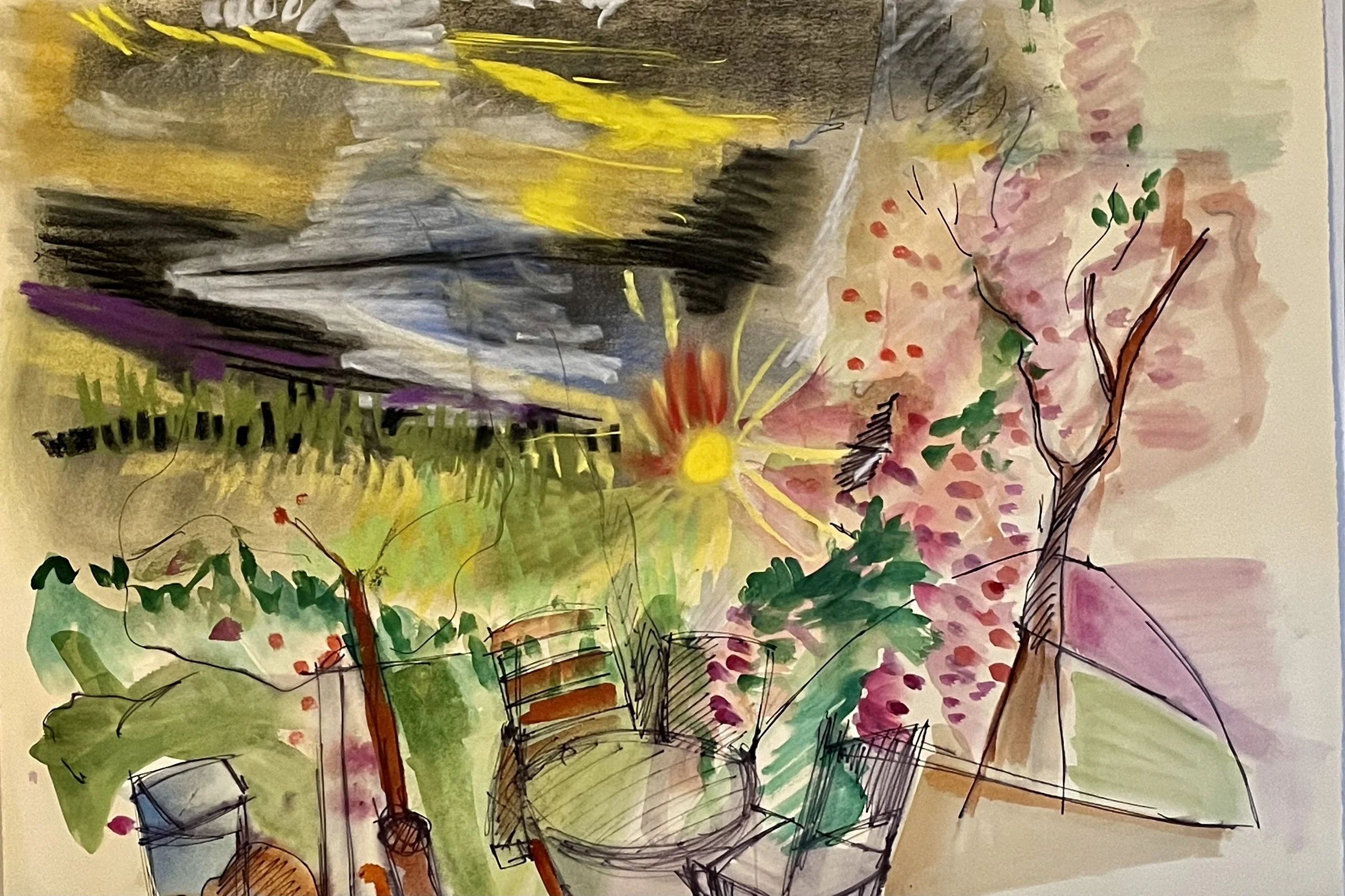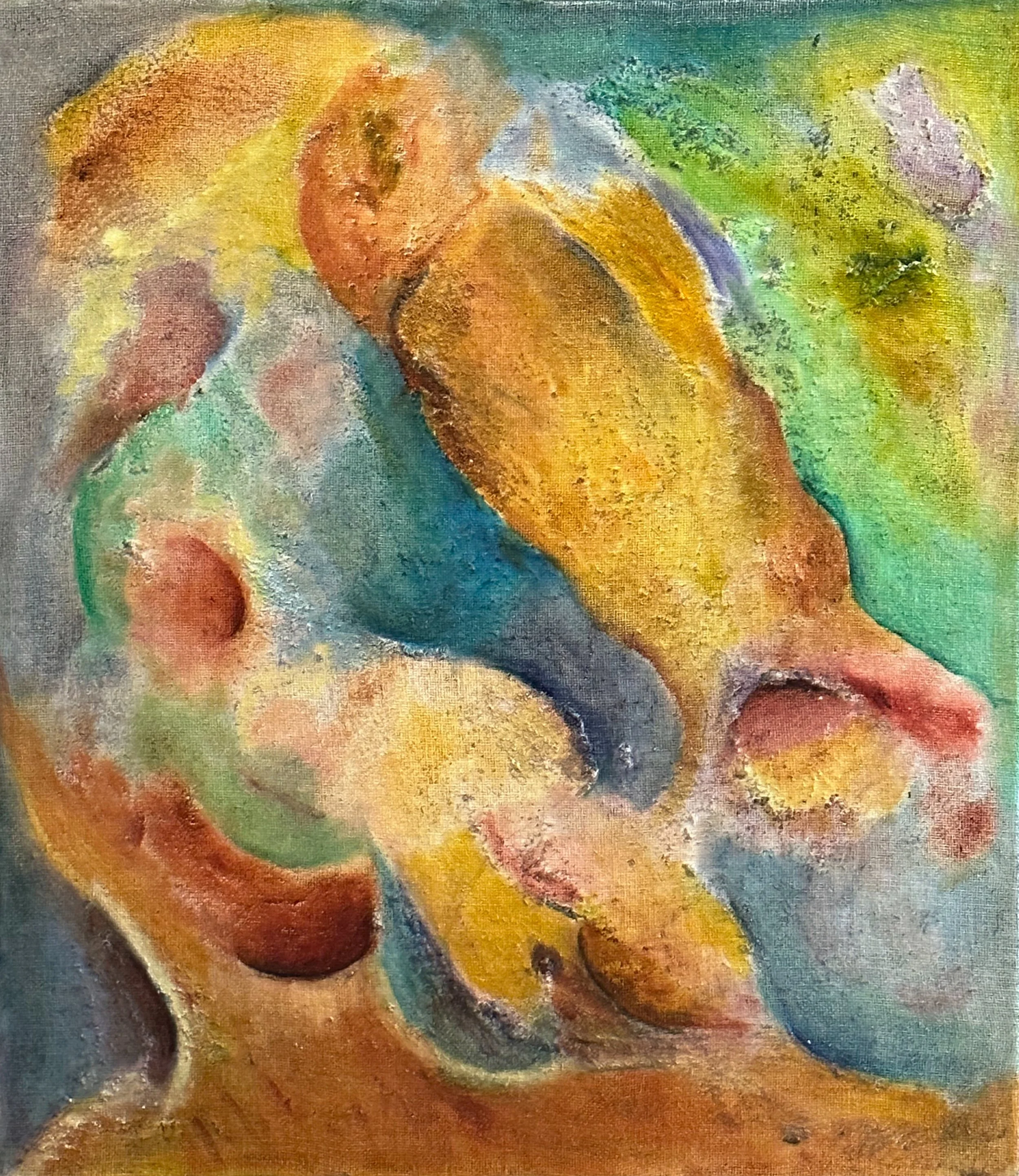Nira Chorev
Among the artists who have sought to reconcile the inner rhythm of memory with the visible order of the world, Nira Chorev occupies a singular position. Her art unfolds in that fragile interval where the photographic fragment meets the drawn gesture, where line negotiates with texture, and where color assumes the role of thought. Across her mixed media works on paper, Chorev constructs a dialogue between nature and recollection, between the personal and the universal. Her art becomes a grammar of remembrance, written in pigment, fiber, and light.
Born in Boston in 1952 and educated in both the United States and Israel, Chorev’s artistic formation bridges continents and cultures. Her early studies at the Art Teachers College in Herzliya and later at the School of the Museum of Fine Arts in Boston grounded her in the disciplines of drawing, printmaking, and photographic experimentation. Those years established the dual foundation of her practice, the precision of the draftsperson and the sensibility of the observer. From the beginning, Chorev understood that the act of seeing is never innocent. To paint, for her, has always meant to measure the distance between perception and emotion.
Her practice evolved through decades of exploration, yet always returned to a central question: how does one preserve the fleeting? The photograph, in Chorev’s hands, is not an end but a beginning. Each image, taken during her daily life, on journeys, or within intimate spaces, becomes the seed from which the painting grows. She prints her photos on matte paper, integrating them into her compositions through layers of pastel, acrylic, and collage. The boundary between photograph and painting dissolves, producing an indeterminate space that oscillates between reality and imagination. It is in this oscillation that Chorev’s art finds its voice.
In Budding, one of her most delicately orchestrated compositions, the viewer encounters a vibrant choreography of organic forms. The painting’s yellow ground radiates warmth, while curvilinear shapes in terracotta and turquoise twist and unfold like petals caught in a moment of metamorphosis. Embedded among them are painted leaves, their veins rendered in green lines that pulse like capillaries. Chorev’s gesture is sensual yet disciplined; her forms breathe rather than describe. The piece evokes the early biomorphic abstraction of Matisse’s cut-outs, yet it also resonates with the post-war organicism of artists such as Jean Arp and Helen Frankenthaler. What distinguishes Chorev is the emotional clarity of her line. In her world, growth is not merely biological but existential, a meditation on renewal, fragility, and the human will to flourish.
Childhood Memories deepens this meditation by binding nostalgia to structure. Here, rectangles of bold color, red, green, black, and ultramarine, alternate with photographic fragments of orange flowers and rounded green leaves. The image within the image becomes both motif and memory. Chorev reconfigures the photograph into painterly syntax, allowing the real to inhabit the abstract. The layering recalls the collage strategies of Kurt Schwitters and the disciplined geometry of Mondrian, yet her temperament remains lyrical rather than austere. Each shape seems to hum with personal resonance, as if the artist were composing a visual fugue of recollection. Color operates not as surface decoration but as emotional architecture. The interplay of organic photograph and geometric abstraction crystallizes her central pursuit, the search for balance, the moment when, as she says, “the painting begins to play its music.”
In Drift, Chorev transports the viewer to the edge of the sea, or rather, to the memory of that edge. Blues unfold in horizontal bands, dissolving into one another like breaths. Photographic fragments of foliage float amid drawn lines that ripple like currents. The surface alternates between transparency and opacity, water and air. The title itself suggests movement without direction, a state of suspension that is both tranquil and vulnerable. Chorev’s composition recalls the meditative chromatic fields of Mark Rothko, yet where Rothko’s color overwhelms, hers invites. The integration of photographic detail grounds the transcendence, reminding us that the sublime is never far from the tangible. Drift is less a seascape than an introspective cartography of longing.
The theme of migration, both physical and emotional, becomes explicit in her Homes on a Journey series. In Homes on a Journey 3, strips of painted fabric and torn paper traverse a landscape rendered in horizontal planes of ochre, lavender, and blue. At the center, a small house-like form, painted in pink and green, anchors the restless field. The striped textile, stitched or collaged across the surface, evokes both sail and shroud, both journey and memory. The image speaks of displacement and belonging, of the fragile shelters we construct to carry our identities across time and space. In these works, Chorev approaches the condition of exile not as tragedy but as continuity, an ever-shifting horizon of experience. Her compositions echo Paul Klee’s pictorial poetics of travel, yet her palette remains unmistakably her own, luminous, feminine, and infused with hope.
That same sensitivity animates My Balcony 3, a work suffused with immediacy. Sketched chairs, a table, and a sunburst occupy a vibrant garden of color and gesture. The drawing feels improvised, almost musical, as if executed in a single breath. Layers of watercolor, pastel, and graphite coalesce into an atmosphere rather than a scene. Here, Chorev’s relationship to nature is intimate rather than monumental; she records not the object but the sensation of looking. The line trembles with empathy, echoing the fluid vitality of Raoul Dufy or the late watercolors of John Singer Sargent, whom Chorev cites among her influences. Yet unlike those predecessors, her perspective remains deeply contemporary. The balcony becomes a metaphor for liminality, a threshold between interior reflection and the world beyond the frame.
In Oaxaca 1, the sensual abundance of color reaches a crescendo. Against a black ground, oversized leaves and blossoms surge forward, interspersed with gold and patterned fragments. The composition is almost baroque in its richness, yet its structure is meticulously controlled. Chorev juxtaposes the natural and the ornamental, weaving together references to tropical flora, textile design, and sacred geometry. The result is a celebration of vitality that transcends locale. The lushness of Oaxaca 1 recalls Matisse’s cut-outs, yet also hints at the spiritual luminosity of Henri Rousseau and the cultural hybridity of Latin American modernism. The painting suggests that nature, far from being an external subject, is an interior state, a place where memory and sensation intertwine.
Transit shifts the mood toward movement and transformation. Planes of red, yellow, and blue intersect with photographic shards, creating a dynamic spatial rhythm. The composition feels architectural, yet its energy remains organic. Lines curve and fracture, guiding the eye through a sequence of transitions. It is a work about thresholds, about the perpetual negotiation between here and elsewhere. The word “transit” acquires metaphoric resonance, the passage between countries, between identities, between stages of life. For Chorev, travel is not displacement but expansion, an opening of perception. Her brush and camera become instruments of navigation through both geography and consciousness.
In Vitrage, Chorev explores transparency and layering through a dialogue between photographic insert and painterly overlay. The work evokes the stained-glass window suggested by its title, yet the luminosity arises not from light passing through color, but from color asserting its own radiance. The planes of blue, purple, and amber modulate gently, while fine lines trace a web of interconnection. The effect is meditative, recalling the equilibrium sought by constructivist painters such as Sonia Delaunay or Moholy-Nagy, yet Chorev infuses it with emotional resonance. Her geometry is never mechanical; it breathes, pulses, and listens. Each section of color becomes a vessel of time, a fragment of experience made visible.
Waking, created in 2022, marks a turn toward gestural spontaneity. Here the surface bursts with immediacy: quick graphite lines, splashes of yellow and rose, and sketched hints of flora. The composition reads as an act of consciousness, the first awareness after sleep. Chorev’s process reveals itself, observation translated into motion, motion into form. The drawing recalls Cy Twombly’s lyricism, yet the mood is less elegiac and more joyful. “Waking” is both noun and verb, the state of being awake and the act of awakening. In it, Chorev affirms painting as a daily renewal of attention, an ethics of seeing.
The aquatic serenity of Water Murmur continues this dialogue between interior rhythm and external nature. Two luminous white stones float within layered blues, while thin lines ripple across the surface like whispered currents. The embedded photograph of foliage beneath the surface suggests reflection, both literal and metaphorical. Water becomes a mirror of consciousness, its surface a threshold between depth and appearance. Chorev achieves here what few painters manage: a balance between stillness and vibration, between the tangible and the infinite. The composition recalls the clarity of Japanese ink painting and the contemplative purity of Agnes Martin, yet filtered through her own sensibility, attuned to music and memory.
Across these works, Chorev’s art articulates a philosophy of balance. The golden cut she seeks is not a mere formal ratio but an ethical ideal, a visual metaphor for harmony between inner truth and external reality. Her process, rooted in attentive observation and fearless experimentation, demonstrates what Rosalind Krauss termed the “post-medium condition,” the state in which art transcends traditional boundaries to become a field of conceptual and material inquiry. Photography, painting, and collage merge into a single organism, each element assuming equal importance in the generation of meaning. Chorev’s mixed media is not eclecticism but synthesis, an articulation of unity amid multiplicity.
Her position within contemporary art is therefore distinct. At a moment when digital imagery floods perception with transient spectacles, Chorev’s works offer the opposite: slow seeing, embodied touch, material thought. She reclaims the tactile intimacy of making while engaging the visual language of modernity. Her works remind viewers that authenticity in art arises not from novelty but from sustained attention. In this, she aligns with the lineage of artists who treated art as a mode of consciousness, Matisse, for whom color was a means of order, Klee, who sought “to make visible,” and Beuys, who transformed personal experience into collective healing. Like them, Chorev insists that the artist’s task is to restore meaning to perception.
Philosophically, her art engages with the dialectic of memory and presence. The photograph, a fragment of the past, becomes a point of entry into the immediacy of painting. Each image is re-imagined, re-experienced, transformed. In doing so, Chorev dissolves the binary between documentary and invention, suggesting that truth lies in the continuity between them. The recurring motifs of leaves, water, homes, and pathways are not symbols in the didactic sense but metaphors for consciousness itself, ever growing, migrating, adapting. Her mixed media thus becomes a visual ethics of coexistence, a celebration of diversity within unity.
In broader social terms, Chorev’s practice speaks to the contemporary condition of displacement and ecological anxiety. Her Homes on a Journey resonates with global narratives of migration, yet it also affirms resilience. Her recurring return to nature, leaves, water, earth, is not escapism but advocacy, an attempt to restore equilibrium in a world out of balance. By merging natural and human imagery, she constructs an aesthetic of care. Her works remind us that the harmony of composition mirrors the harmony we must seek with our environment.
Nira Chorev’s art stands as a testament to the possibility of coherence in a fragmented world. Her mixed media works are not assemblages of disparate parts but living systems of interrelation. Each line, color, and photograph contributes to a totality that is both formal and emotional. Through her lifelong dedication to balance and truth, she transforms personal memory into universal language. Her paintings do not shout; they sing, softly and insistently, of renewal, connection, and the beauty of attentive perception.
In the continuum of contemporary art, Chorev occupies the space where tradition meets invention, where craftsmanship meets philosophy. Her art reaffirms that the act of creation is, above all, an act of care for the world, for memory, and for the fragile equilibrium between them. To stand before her work is to feel time made visible, to sense the quiet music of form and color aligned. In an age defined by speed and distraction, Nira Chorev offers the rare gift of stillness, a stillness that listens, remembers, and most importantly, awakens.
By Marta Puig
Editor Contemporary Art Curator Magazine
Childhood Memories, 2023
Budding, 2024
Waking, 2022
Transit, 2020
Drift, 2023
Water murmur, 2023
Oaxaca 1, 2019
Vitrage, 2019
Homes on a journey, 2022
My balcony, 2025
